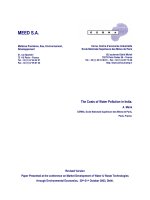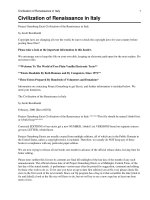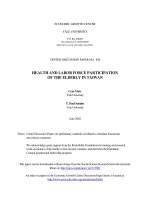Ward architecture of the renaissance in france potx
Bạn đang xem bản rút gọn của tài liệu. Xem và tải ngay bản đầy đủ của tài liệu tại đây (15.2 MB, 307 trang )
09
427THE
ARCHITECTURE
OF
THE
RENAISSANCE
IN
FRANCEI.
SOUTH
WEST
ANGLE
OF
THK
COURT
OF
THIS
LOUVRE,
J'AKIS,
ARCHITECTURE
OF
THE
RENAISSANCE
IN
FRANCE
A
HISTORY
.OF
THE
EVOLUTION OF
THE
ARTS OF
BUILDING,
DECORATION
AND
GARDEN DESIGN UNDER
CLASSICAL
INFLUENCE FROM
1495
TO
1830
BY
W.
H.
WARD,
M.A.
\KCII1TTCCT. ASSOCIATE
OF
THE
ROYAL
INSTITUTE
OK
KKIT1SH ARCHITECTS.
AUTHOR OF "FRENCH
CH-Vl'EAUX
AND
GARDENS
IN
THE XVI.
CENTURY"
VOLUME
1
LONDON
B. T.
BATSFORD,
94
HIGH
HOLBORN
NEW YORK
ClfARLES
SCRIBNER'S
SONS,
153-7
FIFTH
AVENUE
IN
the
title of
these
volumes the
words
"
Architecture
of
the
Renaissance"
are
intended
to be
understood
as
embracing
all
thpse
styles,
whether
of
building
or
decoration,
which
are
ultimately
based
on
Classical
Architecture,
from the
re-intro-
duction
of
classical
forms at the
Renaissance
to
the revival
of
Gothic
in
the
nineteenth
century,
and
the word
"France,"
a
geographical
term
of
more
varied
import
than
is
always
realised,
as
corresponding
roughly
with
the
Continental
possessions
of
the
French
State
immediately
before or after the
Revolutionary
and
Napoleonic
Wars,
i.*.,
in
1791
or
1815.
It
is not
a
little
remarkable that
among
the
mass of literature
on the
subject
(for
which
the reader is
referred
to the
Biblio-
graphical
Note,
p. 495),
no
work
exists,
so far as I
know,
in
English,
or even in
French,
dealing exclusively
with the whole Renaissance
architecture
of France.
Monographs
abound in
various
languages,
especially
French,
on
particular
phases
of
style, buildings,
or
groups
of
buildings,
often admirable and exhaustive. But
the
student
has not
always
easy
access to
them,
time
to
peruse
them,
or sufficient
familiarity
with
any tongue
but
his
own
to
be
able
to use
them
with
full
profit.
For a
general
survey
-of the
subject
he
is
compelled
to
fall
back on the
necessarily scanty
and
condensed
sections devoted
to
it
in
general
histories
of
European
or French
architecture.
Among
these
Fergusson,
owing
to the
mass
of
material
which
has become available since
his
day,
is
now
out
of
date,
while
his
peculiar
point
of view one
scarcely
shared
by any
one without
reserve
at
the
present
day
contri-
butes
to
diminish the
value
of
his
criticism.
English
or
American
histories
still
in
progress
have
not
as
yet
reached
the
period
in
question,
nor is
it
to
be
expected
that
their treatment
of
Renais-
sance architecture
in
any
one
country
can
be
a
detailed
one.
The
present
work is
an
attempt
to
supply
a student
who
has
at
least
a
bowing
acquaintance
with
Classic
Architecture
and
its
influence
in
Italy
at the
Renaissance,
such
as
might
be
acquired
by
reading
Anderson
and
Spiers'
"
Architecture
of Greece
and Rome
"
VI
PREFACE
and
of
Anderson's
"
Architecture
of
the
Renaissance
in
Italy,"
with
an
account of the main trend of
architectural
thought
and
practice
in
France
during
the
period
defined,
and of the
principal
facts
connected
with
important
buildings
and
architects,
set
forth in
their relation
to
political,
social,
and
literary
history.
The
execution
of the task has been
greatly
facilitated
by
the late
Baron
Heinrich
von
Geymiiller's
"Baukunst
der Renaissance
in
Frankreich."
Although
forming
part
of a
so-called
"Hand-
buch,"
this
somewhat unreadable
and
confusingly arranged
work
would
be better described as a
collection
of
materials
for a
history
interspersed
with
essays
on
special
topics.
It
is,
how-
ever,
a
monument of minute and
painstaking
research,
my
indebtedness
to
which it
would
be
difficult to
exaggerate
;
and
I avail
myself
of this
opportunity
to
pay
a
tribute of
admiration
to
the erudition and
usually
sound
judgment
of the
author, who,
unfortunately,
did
not live
to
complete
the
concluding
volume.
Even
Geymuller
does not
profess
to
carry
his
narrative
beyond 1755,
and
therefore
stops
short
of
some
very
interesting
phenomena
still
in
the
direct line
of
Renaissance
descent.
While
this
somewhat
arbitrary
selection
of a
date is
particularly
unfor-
tunate,
it is
obvious
that no
year
can
be
pointed
to as
coinciding
with a
complete
solution
of
continuity
in
the
process
of
develop-
ment,
and
it
is
only
after
much
hesitation
that
I
have
fixed
upon
the
year 1830
as
the terminus
ad
quern
of
this
history.
An
unbroken,
if
varied,
sequence
of
styles,
each
in
turn
paramount
throughout
the
greater
part
of
France,
came
to an
end
with
that
of
the
Empire,
whose
existence,
feebly
prolonged
in
the
midst
of
new
and
disturbing
influences,
may
be
said
to
have
died
out
about the
time of the
fall
of the
elder
Bourbons.
On the
other
hand
the
work
resulting
from
these
influences in
the
succeeding
period
is
too
eclectic
to
possess
the
recognisable
characteristics
of
a
style,
and at
the
same
time
perhaps
too
near
our
own
day
to be
seen as
yet
in
its
true
perspective.
Any
conceivable
subdivision of
the
subject
is
open
to
some
serious
objection,
and
I am
fully
conscious
that
the
system
adopted
in the
following
pages,
of
-a
classification
by
reigns,
is
by
no
means an
exception.
Its
inevitable
drawbacks
will,
how-
ever,
be
reduced to
a
minimum,
if
it
be
remembered
that
each
chapter
deals,
not so
much
with
the
architecture
produced
during
the actual
reign
of
the
sovereign named,
as
with
a
stylistic
development
culminating
in
that
reign,
and
extending
between
PREFACE
vii
two
approximately
assigned
dates,
and
secondly
that,
chrono-
logically,
these
periods
of
development
usually
overlap,
some-
times
to a
considerable
extent. The
system
has this
advantage,
that
the
names
of
sovereigns
have
acquired
a
distinct
meaning
in trade
and
conversational
diction,
and
call
up
in
the mind a
certain historical
background
fraught
with
suggestions
of
con-
temporary
events,
manners,
and
costume.
It
is
also
justified
by
the fact
that,
in
France,
the
Court
and Government have
exerted
a
more
sensible
influence
on
the evolution
of
design
than
in less
centralised
states.
In
the
matter
of
illustration it has been
my
aim to
place
before the
reader in
the first
place,
of
course,
photographs
and
modern
drawings
of
buildings,
now,
or
till
recently standing,
but also
the vanished
buildings
and unexecuted
projects
which
throw an
equally strong light
on the ideas which
inspired
the
work of
successive
ages.
That this must
generally
be
done
by
reproducing
the
drawings
of
by-gone
generations
of
designers,
so
variously
different
in
character
from those
of our
own
day,
is
in
itself
a
gain,
since the
graphic
method of
presentment
adopted by
a du
Cerceau,
or
a
Marot,
a
Neufforge
or a Fontaine
is
one element in his
conception
of
design,
and should
be
taken
into
consideration
in
the
study
and
appreciation
of
the
style
in
which he
worked.
The
subject
of
this
history
is
so wide
that
it
necessarily
includes much matter of a controversial nature. This turns
principally
on
the
dates
and
authorship
of
buildings
anterior
to
the
seventeenth
century,
whose records
are
fragmentary
or
non-existent. The
limits of these volumes
have
obliged
me
in
many
cases
to
assert facts or
probabilities,
without
supporting
such
assertions
by
arguments
or reference
to authorities.
Those
who wish to
investigate
such matters
further
will,
in
most
cases,
find the
points fully
discussed
in
the serried
pages
of
Geymiiller,
who,
if
his conclusions
occasionally appear
to
go
beyond
the
point
which his
argument
warrants,
never
fails to
set
forth with
the
utmost
candour
all the
available
evidence,
together
with
the
opinions
of
other writers.
One
of
his
most
notable contributions
to
scholarship
has
been
finally
to
dispel
the
mists
introduced
into
the
subject
by
Chauvinistic
French writers
of
the
last
century,
with the late
M.
L6on
Palustre
at
their
head.
The
aim
of this
school was
to
reduce
the
influence
of
Italy
on the French
Renaissance
to
the
VI11
PREFACE
vanishing
point.
Their
arguments
were
chiefly
based
on
the
fact
that
building
accounts
of
the
period,
which
are
extant
in an
admittedly
incomplete
state,
seldom mention
the
names of
eminent
Italians,
who
were often
paid
by
the
grant
of benefices
and
Court
sinecures,
while
they
do include
the names of
obscure
Frenchmen,
whose
small
daily
salaries are often
sufficient
evidence
of their subordinate
positions.
Again
they
laid
more
stress
on
differences
of
style
between works
in
France and
Italy
than is
found
to be
justified
if
the
proved
versatility
of Italians
working
in
other
lands
is
taken into
account.
A
reaction
has
since
set
in,
and
though many
questions
still remain
unsolved,
French
writers of
the
present day
are,
as a
rule,
ready
to
agree
with the
view
taken
in
the
following
pages,
that from
the
last
years
of
the
fifteenth
century, Italy
intervenes
in a
decisive
manner
in
the
destinies of
French
art.
W.
H.
WARD.
2
BEDFORD
SQUARE,
W.C.
1911.
AUTHOR'S
NOTE
OF
ACKNOWLEDGMENT
I TAKE
this
opportunity
of
acknowledging
with
gratitude
my
great
and
various
obligations
to all
those
who
have
lent
me
their
aid
in
the
pro-
duction
of these
volumes.
Among
these
the
first
place
belongs
to
my
friend
Mr
John
W.
Simpson,
to
whose
suggestion
the work
owes
its
origin,
and to whose
unfailing
good
nature and
unerring judgment
I have
frequently appealed
and
never
in
vain at
critical
junctures.
To Mr
Arthur
Stratton
I
owe
a
deep
debt
for
valuable
advice
and
criticism
in
the
revision of the
work and
the
selection of
illustrations,
involving
much
work
and considerable
inconvenience
to himself.
My
thanks
are
also due to
Mr
Arthur
Tilley,
of
King's
College, Cambridge,
and
to
Mr
R.
Phene*
Spiers,
for
various
suggestions,
and
to the
latter for
the
loan
of
a
number
of
photographs.
I
am
greatly
indebted to
Mr
Alan
Potter for
his
admirable
photo-
graphs,
many
of
which
were
taken
expressly
for
this
work,
and
to
Messrs
Lawrence
Gotch
and
Philip
Hepworth
for
their
excellent measured
drawings
and
sketches.
I also
gratefully
acknowledge
the
permission
to
reproduce
drawings
by
Messrs
Louis
Ambler,
C.
Farey,
C.
W.
Pike,
V.
O.
Rees,
Arthur
Stratton,
and G. G.
Wornum
;
the kind assistance
given
me
by
Mr T.
Honnor
in
photography
and
typewriting,
and Mrs .
Lament's
invaluable
help
in
compiling
the Index
and
reading
the
proof.
I
have
also
to
record
my
indebtedness
to the
Council
of
the
Royal
Institute
of British Architects for
subjects
from old
books and
prints
in
the
Library,
and
to Messrs
Arnott
and Wilson for
Fig.
402.
Thanks are due
to the
French
publishers
who have with characteristic
courtesy
permitted
me
to
reproduce examples
from their valuable works.
Details
of
the
subjects
and their sources are
given
in
the
Index to
Illustrations.
Their
names
are as
follows
: Messieurs F.
Boissonas,
Geneva;
E.
Twietmeyer,
Leipzig;
A.
Calavas,
F,
Contet,
Ch.
Eggimann,
Ch.
Foulard,
A.
Gu&inet,
and
E.
Levy,
all of Paris.
I
can
only
fitly
conclude this note
by expressing
my gratitude
to
my
Publishers for
their kindness
and valuable
help
in
many ways
throughout
the
long
preparation
of the
book,
and
in
particular
to
Mr
Harry
Batsford
for his laborious
work
in
connection
with the illustrations and
printing.
W.
H.
W.
VOLUME
I.
INTRODUCTION.
PAGS
FRANCE IN
THE
XVTH
CENTURY
NATIONAL
DISORGANISATION
AND
REVIVAL
FRENCH
GOTHIC
ARCHITECTURAL
NEEDS
OF
FRANCE
CHANNELS OF
ITALIAN
INFLUENCE
ON FRENCH
ART
THE
RENAISSANCE
IN
ITALY:
LOMBARD,
ROMAN,
SCHOLASTIC,
AND
BAROCCO PHASES
FUSION
OF
ITALIAN
AND
NATIVE
ELEMENTS
IN
FRENCH
ARCHITECTURE
RESULT-
ING
STYLES
vv
CHAPTER
I.
STYLE
OF
LOUIS
XII.
(1495-1515).
BEGINNINGS
OF
ITALIAN
INFLUENCE
ATTEMPTED
FUSION
BETWEEN
LOMBARD
RENAISSANCE AND
FLAMBOYANT
GOTHIC.
REIGNS OF CHARLES
VIII. AND
LOUIS XII.
EFFECTS
OF
ITALIAN CAM-
PAIGNSITALIAN DESIGNERS
AND
CRAFTSMEN INTRODUCED
COLONY
OF AMBOISE: FRA
GIOCONDO
FRENCH
BUILDERS
CHARACTER OF
HYBRID STYLE
CHATEAUX, HOTELS,
PUBLIC
BUILDINGS:
GAILLON,
BLOIS,
ETC.
CHURCHES
AND TOMBS
CHAPTER
II. STYLE
OF FRANCIS
L
(1515-45)-
FUSION
BETWEEN NATIVE
STYLE
AND
LOMBARD
RENAISSANCE
COMPLETED.
REIGN OF FRANCIS
I. BUILDING ACTIVITY INFLUENCE
OF COURT CHAR-
ACTER OF
EARLY RENAISSANCE
STYLE IN
FRANCE LOIRE CHATEAUX:
BIX>IS,
CHAMBORD,
ETC. ITALIAN
DESIGNERS
AND
CRAFTSMEN
:
BOCCA-
DORO
FRENCH
BUILDERS OTHER
CHATEAUX:
MADRID,
FONTAINE-
BLEAU,
ST
GERMAIN
HOUSES PUBLIC BUILDINGS
CHURCHES
AND
TOMBS :
ST
EUSTACHE, ETC.,
AMBOISE TOMB
-
-
-
"44
xi
Xli
CONTENTS
CHAPTER
III.
STYLE
OF
HENRY
II.
(i53-9)-
INFLUENCE
OF ROMAN
RENAISSANCE.
PAGE
END
OF
FRANCIS
I.'S
REIGN
SCHOOL
OF
FONTAINEBLEAU:
.ROSSO,
PRIMA-
TICCIO,
SERLIO
ANCY-LE-FRANC
RISE
OF
NATIVE
ARCHITECTS
:
DU
CERCEAU,
GOUJON,
LESCOT,
DE
L
J
ORME,
BULLANT
TRANSITION
FROM
EARLY
TO
ADVANCED
RENAISSANCE
REIGN
OF
HENRY
II.
INFLUENCE
OF COURT-
CHARACTER
OF ADVANCED
RENAISSANCE
IN FRANCE:
SEVERE
AND FREE
SCHOOLS
THE
LOUVRE,
ANET,
MONCEAUX
HOTELS
DECO-
RATION
REIGNS
OF
THE
LAST
VALOIS
KINGS
ARCHITECTURE
DURING
THE
CIVIL
WARS
CHARACTER
OF
LATER
RENAISSANCE
TUILERIES,
VER-
NEUIL,
CHARLEVAL
GARDEN
DESIGN
HOTELS,
ETC.
ARCHITECTURAL
LITERATURE
CHURCHES
AND
TO^BS
TRANSITIONAL
TYPE
: BRETON
CHURCHES
CLASSIC
TYPE': CHAPELS
AT
ANET,
VALOIS
MAUSOLEUM
-
113
CHAPTER
IV. STYLES
OF
HENRY
IV. AND
LOUIS
XIII.
(1590-1660).
UTILITARIAN
ARCHITECTURE
AND RIVAL
TENDENCIES OF
NETHERLANDS
BAROCCO
AND
ROMAN
CLASSICISM.
REIGNS
OF
HENRY
IV.
AND
LOUIS
XIII. EFFECTS
OF
POLITICAL
AND
RE-
LIGIOUS
SETTLEMENT
BOURBON
ART
POLICY
ADVANCE
IN PLANNING
BRICK
AND STONE ARCHITECTURE RUSTICATION
DE
BROSSE,
L.E
MERCIER,
LE
MUET,
F.
MANSART WORKS AT THE LOUVRE AND
TUILERIES,
FONTAINEBLEAU
AND ST
GERMAIN;
THE
LUXEMBOURG,
RICHELIEU,
BLOIS,
ETC. HOTELS
TOWN,
PLANNING
DECORATION
CHURCHES
HUGUENOT AND
JESUIT
ARCHITECTS
DOMES
TOMBS
-
206
VOLUME
II
CHAPTER
V. STYLE
OF
LOUIS
XIV.
(1640-1710).
BAROCCO-PALLADIAN
COMPROMISE
"THE
GRAND
MANNER."
REIGN
AND
ART
POLICY OF LOUIS
XIV.
AND HIS
MINISTERS
THE
ACADEMIES
ARCHITECTURAL
LITERATURE
VARIOUS
ORIGINS
OF
THE
STYLE
ITS SUMPTUOUS CHARACTER
EARLY
DOMESTIC
ARCHITECTURE: F.
MAN-
SART,
LE
VAU PARISIAN
HOTELS
CHATEAUX
:
MAISONS,
VAUX,
ETC.
DECORATION: LE
BRUX,
LE
PAUTRE,
J.
MAROT
GARDEN
DESIGN:
LE NOTRE PALATIAL
ARCHITECTURE
: LE
VAU,
BERNINI,
PERRAULT,
J.
H.
MANSART
COMPLETION
OF
LOUVRE
AND
TUILERIES
;
VERSAILLES,
MARLY,
ETC.
PUBLIC
WORKS
AND
MONUMENTS
LATER
DOMESTIC
ARCHITECTURE AND
DECORATION
:
BERAIN,
DE
COTTE
CHURCH
ARCHITECTURE BASILICAN
AND
DOMICAL
TYPES:
ST
SULPICE,
SOR-
BONNE,
VAL-DE-GRACE,
INVALIDES,
VERSAILLES
CHAPEL
-
-
267
CONTENTS
xiii
CHAPTER
VI.
STYLE
OF
LOUIS XV.
(1710-70).
Rococo -PALLADIAN
COMPROMISE.
PAGE
REGENCY
REIGN OF
LOUIS
XV.
SOCIAL
ATMOSPHERE
COMFORT
AND
ELE-
GANCEDECORATION
:
"REGENCE,"
ROCOCO,
"
ROCAILLE,"
"
CHINOI-
SERIES"
DECOTTE,
WATTEAU CURVILINEAR AND
ASYMMETRICAL TEN-
DENCIES:
OPPENORDT,
MEISSONN1ER
ACADEMIC TRADITION :
BOFFRAND,
J. J.
GABRIEL ARCHITECTURAL EDUCATION
J.
F.
BLONDEL
DOMESTIC
AND PUBLIC
ARCHITECTURE
PARISIAN
HOTELS CHATEAUX FRENCH
INFLUENCE
ABROAD
TOWN
PLANNING :
NANCY,
PARIS CHURCHES
-
356
CHAPTER
VII. STYLE OF LOUIS
XVI.
(1730-90).
PURISTIC
REACTION
BEGINNINGS
OF
ARCHAEO-
LOGICAL
TENDENCY.
END OF
LOUIS
XV.
'$
REIGN AND
REIGN OF LOUIS
XVI.
CAUSES OF
FRENCH
REVOLUTION
ARCH^OLOGICAL
DISCOVERIES
INFLUENCE
OF
ROUSSEAU
ANGLOMANIA
SERVANDONY,
J.
A.
GABRIEL,
SOU
FFLOT
STRAIGHT
LINES
AND SYMMETRY
RESTORED
CLASSICAL
PURISM
PALATIAL
AND
DOMESTIC
ARCHITECTURE:
COMPIEGNE,
PETIT
TRIANON
THE
ENGLISH
GARDEN
HOTELS DECORATION
TOWN
PLANNING
PUBLIC
BUILDINGS,
THEATRES
ANTOINE,
LOUIS CHURCHES:
PANTHEON
- -
"
4O7
CHAPTER
VIII.
STYLE OF
THE
EMPIRE
(1790-1830).
ARCHAEOLOGICAL
CLASSICISM.
THE
REVOLUTION
AND
NAPOLEON
BREAK
UP
OF INSTITUTIONS
AND
TRA-
DITIONSINCREASED
INTEREST
IN CLASSICAL
ANTIQUITY
PERCIER
AND
FONTAINE
PUBLIC
WORKS
AND
MONUMENTS
:
ARCHES,
COLUMNS
:
MADELEINE,
BOURSE
TOWN
PLANNING
TOMBS
CHURCHES
CHARAC-
TER
OF
RESTORATION
PERIOD
REVIVALS
DECLINE
OF CLASSICISM
-
466
BIBLIOGRAPHICAL
NOTE
-
-
-
- -
-
-
495
INDEX
TO
ILLUSTRATIONS
-
-
-
-
- -
-
S
01
INDEX
TO
TEXT
508
THE
CHATEAU OF
TANLAY.
THE
ARCHITECTURE
OF
THE
RENAISSANCE IN
FRANCE
INTRODUCTION
DURING the
fifteenth
and
sixteenth
centuries
the
peoples
of
Europe,
led
by
Italy,
passed
from
their
mediaeval to
their
modern
stage
of
development,
with all
that
those
expressions
imply.
The
great
transforming process,
which
brought
this
about,
and
was
to a
great
extent
inspired by
the
New
Learning,
or
recovered
lore
of
Classical
Antiquity,
is known as
the Renaissance.
The
value
of
its
character
and work has
been
variously
estimated
at
different
periods,
but
we
have
now
emerged
from
the
controversial
era,
and with
the
growth
of
the
historical
spirit
it
can be viewed
dispassionately,
as
an
inevitable
step
in the advance of
civilisation,
not
more
exempt
from
defect
than
others. The twentieth
century may,
in
fact,
be
content
to strike a
balance
between the abuse
with which the
nineteenth
attacked the
Renaissance
and the indiscriminate
admiration
with
which
it
was
previously regarded.
Its
history
has
been
told,
and told
exhaustively,
from
almost
every
point
of
view.
The task
attempted
in
these
pages
is to
trace its
effects,
both immediate and
secondary,
on
the art of
architecture
in
France,
a
country
which
for
a
thousand
years
has
played
so
commanding
a
part,
xvi
INTRODUCTION.
in
European
civilisation
that no
aspect
of
its
own
civilisation
can
fail
to
be
of
importance
for its
neighbours.
All^Renaissance
architecture
must
in
some
degree
be
of
a
hybrid
character,
the
resultant of
an
endeavour
to clothe
structures
adapted
to
the
requirements
of
a later
age
in a
code
of
forms
and
proportions
derived
from
the architecture
of
classical
antiquity
to
recast
a national
style
in a classical
mould.
Thp
character
of the
outcome
of
such
a
process
of
assimilation
naturally
varies in
proportion
to the force of
resistance
exerted
by
the
national
style.
But
it is not
less
interesting
or
valuable
to
study
it
when,
as in
the case of
France,
that resistance is
strong,
than
when,
as
in
the case
of
Italy,
it
hardly
existed.
In
Italy
the
distance traversed
by
the national
styles
from the
common
classical
starting
point
was but small.
And
nothing
is
more
striking
in
her mediaeval architecture than
the
persistence
in
it
of
classical
traditions
of wall
and
space composition,
of
horizontality
and
dead-weight
construction,
as well as of
detail and
features,
and
the
influence
they
exerted
upon
exotic
styles
of
diverse
origin
imported
into
the
peninsula
from
time
to
time.
At
first,
in
Tuscany
at
least,
the
difference
between
the
later
Romanesque
buildings
and those
affected
by
that
study
of
ancient
monuments
which
Brunelleschi
revived,
is
principally
manifested
by
a
closer
systematisation
of
design
and
increased
refinement of
detail.
In
France,
where the
national
style
had
reached
a
stage
of
development
which
constituted the
almost
direct
antithesis
of
its
remote
classical
origin,
the
fusion was
effected
with
far
less
ease
; and,
if
for
that
reason
its
results
but
seldom rival
the
best
works
of
the
Italian
Renaissance
in
ideal
charm,
they
yet
possess
a
haunting
interest,
and
offer
perhaps
even
more
suggestion
.for
the
modern
world
by
reason
of
the
traces
of
struggle
which
they
bear
upon
them.
Gaul
had been
almost
as
thoroughly
permeated
with
Latin
civilisation
as
Italy
herself,
but
the
proportion
of
the
northern
invaders
Visigoths,
Burgundians,
Franks,
and
Northmen
to
the
Romanised
population
had
been
greater,
and
the
influence
of
Germanic
institutions
more
powerful.
In the
new
state
which
emerged
there
after
centuries
of
obscure
conflicts,
the
civilisation of
mediaeval
Europe
reached
its
fullest,
its
most
characteristic,
expression.
From
the
twelfth
to
the
fourteenth
century,
and
especially
in
the
reigns
of
Philip
Augustus
and
Saint
Louis,
this
state
was
gaining
in
consistency,
power,
and
territory,
and
France
took a
leading
part
not
only
in
the
political,
but
also in
the
spiritual,
intellectual,
and
artistic
life
of
Europe.
This
was
the
heroic
age
of
crusading
and
chivalry,
of
the
religious
orders
and
the
guilds,
of
scholastic
theology
and
cathedral
building.
It
was
followed
by
one
of
growing
prosperity
and
refinement,
but
declining
vigour,
which
ended
in
the
disasters
of
the
Hundred
Years'
War
(1337-1453).
INTRODUCTION.
xvii
After
suffering
the
miseries
and
degradation
consequent
on
foreign
invasion and internal
strife,
the
country
was
gradually
restored
to
inde-
pendence
and
unity by
the
heroism
of
Joan
of
Arc
and
the
astute
policy
of
the
reigns
of
Charles VII.
(1422-61)
and
Louis XL
(1461-83).
A
new France then
arose.
from her
ashes with
the feudal
and ecclesi-
astical
ideals of the
Middle
Ages
greatly
shaken. A
successful
struggle
against
the
invader had
awakened
a
new
sense
of
nationality
and of
solidarity
with
the
crown,
the one
mediaeval
institution
which
emerged
unweakened from
the
anarchy.
The
kings
set
on foot a
work
of
reorganisation, by
developing
the central
administrative,
judicial,
fiscal,
and
military
system
at
the
expense
of
the
local
and
feudal
ones.
They
made themselves
paramount
over
all
conflicting
powers
:
they
controlled
the
Church and the
municipalities,
and
deprived
the
nobles of their
independent
authority,
absorbing
their
territories
and
enrolling
their
persons
in
the
royal
armies.
They
fostered
industry
and
trade;
and
the
restoration of
order
and
prosperity,
which
permitted
the rise of
an
influential
middle class of
lawyers,
bankers,
and
manufacturers,
was
accompanied by
the
growth
of
the
capitalist
principle
in
commerce.
The
newly
invented
printing
press
favoured
the
spread
of
education.
Literary
activity
and
classical studies
revived,
and the
growth
of
Humanism
went
hand
in
hand with that of
individualism.
This national
history
had been
accompanied by
a
highly
char-
acteristic
architectural
development,
culminating,
when
the
mediaeval
monarchy
was at its
height,
in a
noble
austere
style
with
simple
structural
forms
and
symbolic
sculpture,
architectonic
in
its character.
In
the
ensuing
era of material
progress,
the structural
problems being
already
solved,
the
builders devoted
themselves
to
elaboration
and
embellishment
;
while
losing
in
virility,
architectural
forms
grew
richer
and
more
graceful, sculpture
more
purely
decorative.
With
the
national
disorganisation
and
impoverishment
during
the
Hundred
Years'
War,
came a moral and artistic
decline. Architecture
was
reduced to
embroidery
on old
themes,
and lost
itself in
ingenuities
of
design
and dexterities of
execution,
while
sculpture
fell into an ex-
travagant
naturalism. This was
the state of
affairs in the second
half
of
the fifteenth
century
when the
national revival
and
renewed
prosperity
called for
a
new outburst of
architectural
activity.
France under
Louis XL
produced
work
of considerable
magnifi-
cence,
but
the
Dukes of
Burgundy,
the last of
the
great
vassals to be
subdued,
were
far more liberal
patrons
of
art than the
French
king.
In
their
territories,
which
included
a
large part
of the
present
Belgium
as
well as the eastern
provinces
of
France,
and
which
had
to
a
great
extent
escaped
the devastation
of
the
English
wars,
architecture
had entered
upon
a
phase
of
exceptional
splendour,
in
which
all
the
characteristics
of
contemporary
Gothic,
virtuosity,
exuberance
and
naturalism,
were









